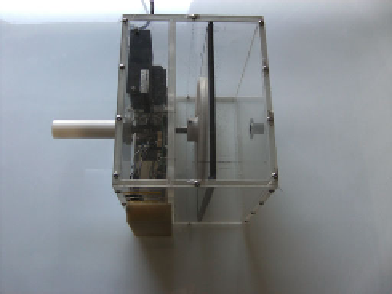Biomedical Engineering Reference
In-Depth Information
Fig. 9.2
Photo of the lab
prototype, only the
mechanical box. The tubing
segment connecting to the
patient is not shown
one realization provides insight into the amount of non-linear distortion in the sys-
tem. A comprehensive description of these methods and a manifold of illustrative
examples are given in [
136
].
9.2 Non-linear Effects from Measuring Device
The measurements of the signals analyzed in this paper have been performed us-
ing the device depicted in Fig.
9.2
: the commercial FOT standard setup, assessing
respiratory mechanics in the range from 4 Hz to 48 Hz and a laboratory prototype
developed to measure a lower range of frequencies, namely 0.625 Hz to 22 Hz. The
low-frequency multisine in the prototype allows excitation of respiratory tissue at
frequencies where viscoelastic properties become important and relevant for clini-
cal insight.
The loudspeaker-based device from Fig.
3.1
was used as a reference for building
the lab prototype. To create a multisine with a frequency range below 4 Hz with a
pressure excitation signal of a sufficient amplitude, it is necessary to find an alter-
native actuator for the loudspeaker and build a lab prototype device. The presented
solution in this chapter is a pneumatic piston with an internal air-volume of ap-
proximately 8.4 liters, as in Fig.
9.2
. This pneumatic piston is connected to a round
marionette, further connected through a gear to a stepper motor. By using a stepper
motor the device is able to reach a sufficient level of volume resolution, which is
necessary to create the desired multisine input signal. The large volume allows to
reliably create the desired multisine with a peak-to-peak amplitude of 0.35 kPa, or a
sinusoidal pressure wave of 0.35 kPa from 0.625 Hz onwards (a lower limit for the
excited frequency originated with the trade-off between device size and expected
performance).
During the measurements, the patient wears a nose clip (nc) and keeps the cheeks
firmly supported. Before starting the measurements, the frequency response of the
transducers (PT)—SensorTechnics HCLA 12X53B—and of the pneumotachograph
(PN)—Hans Rudolph 4830 series from 0-400 L/min—are calibrated with a known

